The Lehigh Valley Transit Co. operated interurban service between Allentown and Philadelphia from 1901 until 1953. The Philadelphia Division was abandoned on Sept. 10, 1951. On this division the trains shared trackage with the Philadelphia and Western (now SEPTA's Route 100 Norristown Line) from Norristown to 69th Street Terminal. Though abandoned in 1953, many stations still exist, and most of the right of way can be relatively easily followed. This page provides a sample of what can still be seen of the LVT infrastructure between Norristown and Quakertown, and is not meant to be a comprehensive photo coverage of the current condition of the right-of-way. North of Quakertown most of the line traversed fields, and while a pole line provides evidence of the route, it is not easy to follow by roads.
To view larger versions of the images, simply click on the image. |
| |
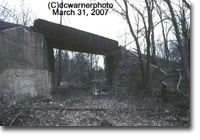 |
Between Norristown and Lansdale the line was never far from the Reading line between the same towns. The rail line is now CSX's Stoney Creek Branch. LVT's double track line crossed under the railroad about a mile south of Lansdale. The creek under the bridge was not there when the rails were in place. This view looks southeast. |
| |
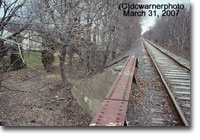 |
Looking north along the Stoney Creek Branch. The LVT curved north after crossing under the rail line and ran in what is now the backyard of a 1970s-era housing development. |
| |
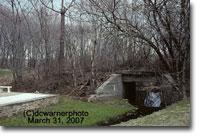 |
North of Lansdale, where the LVT ran in city streets to serve a station adjancent to the Reading Line's station that still sees SEPTA commuter trains, the LVT again used a private right-of-way to reach Hatfield. Near that town, off Koffel Road, the line crossed a small creek on this concrete structure. The Reading also ran trains through Lansdale to Allentown, providing competition through the decades. Commuter trains to Quakertown and Doylestown survived into the SEPTA-era, but now only the Doylestown line sees passenger service. |
| |
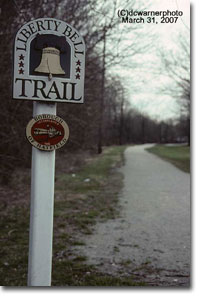 |
This view looks southeast from the area of the Hatfield station where the roughly a mile of the right-of-way has been converted into the Liberty Bell Trail. |
| |
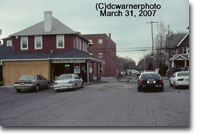 |
Turning 180-degrees, one sees the Hatfield station that even today looks pretty much as it did when the Liberty Bell Limited called here. A cafe now occupies the building. The right-of-way continues northeast in the center background of the photo to the impressive Gehman Tressle, about one mile away. |
| |
 |
| |
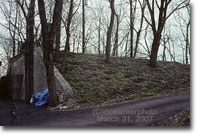 |
The southeast abutment of Gehman Tressle. The owner of the adjacent property has put a gazebo on the right of way, and storage sheds at the base of the abutment. |
| |
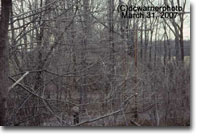 |
Looking from the southeast abutment across East Township Line Road to the northeast abutment. In the summer leaves obstruct this view. |
| |
 |
The northeast abutment of Gehman Tressle. In Souderton, a mile from here, the tracks again were located in city streets. |
| |
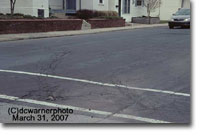 |
In Souderton, the LVT had a station near the Reading station, and then the tracks headed northwest on Main Street, roughly paralleling the Reading. At Summit Street the LVT crossed over the Reading line, A carbarn with running repair facilities was located near here. This view looks from Main Street into Summit Street where the rails are reappearing from beneath asphalt. |
| |
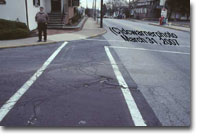 |
Looking the other way from the previous view, one can see a bit down the hill of Main Street to the center of town where the station was located. |
| |
 |
| |
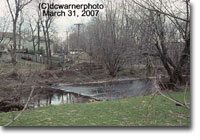 |
Between Souderton and Sellersville, a pole line is largely the only indication of the former presence of the LVT, especially in Souderton where residential development has occured. Approaching Sellersville, the LVT crossed Pleasant Spring Creek. This view looks southeast along the alignment of the LVT's crossing. |
| |
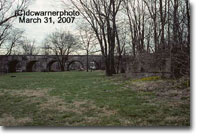 |
The LVT's right-of-way was frequently very close to the Reading's. This view looks south along Pleasant Spring Creek and shows the northeast abutment of the LVT's bridge at right with the Readings's impressive stone arch bridge in the background. The Reading line is on a significant grade from here to beyond Perkasie where a large station was located. |
| |
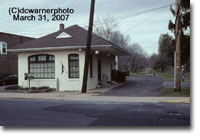 |
The Sellersville station is now a dentist office. The path beyond the station follows the former tracks, and a concrete signal base is still visible about 200 feet beyond the timber fence. |
| |
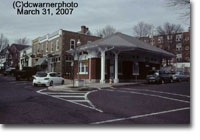 |
Perkasie station, looking northwest. The main line was on Walnut Street, in the foreground, and a siding was adjacent the the right side of the station. |
| |
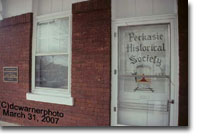 |
The Perkasie station is now home to the Perkasie Historical Society. The door pays homage to the Liberty Bell Limited. |
| |
 |
| |
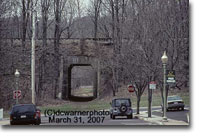 |
Looking northwest along Main Street from near Perkasie station, the LVT crossed under the Reading line. While the Reading had been climbing steadily since Sellersville, the LVT covered most of the elevation difference on Walnut Street after leaving the bank of Pleasant Spring Creek. |
| |
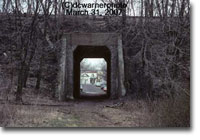 |
Looking southeast back towards Perkasie from the other side of the Reading right-of-way. The grade of Walnut Street is evident. The LVT station is just out of the view at the right side of the tunnel. |
| |
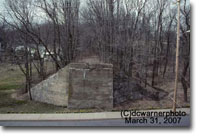 |
Continuing northwest, the LVT crossed 9th Street several hundred feet beyond the tunnel under the Reading. From here the right-of-way climbed a hillside until joining up with (now Old) Bethlehem Pike. |
| |
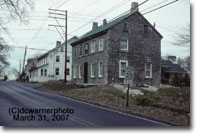 |
Rich Hill. The LVT was located to the east of the roadway, the paved surface of which was much narrower when the trains ran. The speed limit sign is located "between the rails," the edges of the front stoops shows the limit of the right-of-way. |
| |
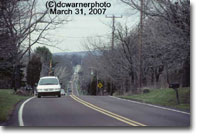 |
The view from Rich Hill north towards Quakertown shows the hilly-profile of this portion of the line. The stone retaining walls of the buildings on the right side of the roadbed show the limit of the right-of-way. |
| |
 |
| |
 |
Quakertown, Main and Broad Streets, looking north. This was the LVT station. The tracks approached from Main Street, and then turned onto a private right-of-way beyond the station. |
| |
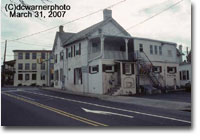 |
The rear of the Quakertown LVT station as seen from Main Street. |
| |
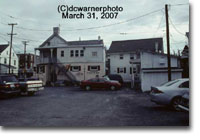 |
This paved area held the main line track as well as a siding that and team track. The freight building is at the right of the photo. |
| |
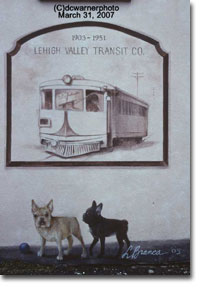 |
A painting done on the rear wall of the LVT station in 2003 commemorates the building's heritage. |
| |
 |
| |

